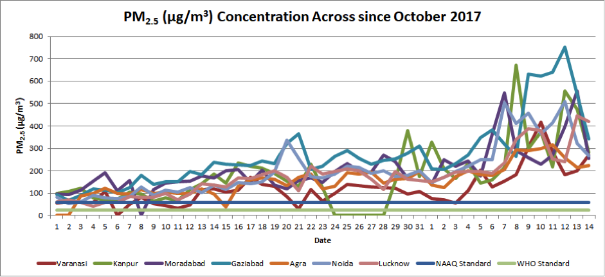New Delhi 16th November 2017| While Delhi has been in the headlines for one of the worst air pollution crisis in its history, Uttar Pradesh, the densely populated State of India bordering Delhi, is also witnessing hazardous air pollution levels. Prominent cities such as Varanasi, Lucknow, Kanpur, Allahabad, Noida, Ghaziabad, Agra and Moradabad are constantly witnessing high PM2.5 concentration. According to the Central Pollution Control Board data, the air quality in these cities has reached way beyond “severe” category.
The PM2.5 levels across Uttar Pradesh on 13th November 2017 were 556 in Moradabad, 541 in Ghaziabad, 474 in Kanpur, 445 in Lucknow, 323 in Noida, 214 in Agra, and 201 in Varanasi. Overall the air quality in these cities is no less polluted than Delhi which noticed PM2.5 levels at 359 µg/m3 on the same day.
“Hazardous pollution levels are not just restricted to Delhi. Entire north India is grappling with a virtual public health emergency. The problem is quite severe. And yet we are looking at Delhi’s pollution scenario alone by turning a blind eye to health of people living across other regions exposed to equally hazardous pollution levels. Uttar Pradesh is a classic case of this. There are other cities in the Indo-Gangetic plains spanning right from Punjab going all the way to UP and Bihar that are just as polluted as Delhi. This clearly depicts that air pollution is a regional issue and solution to this lies in acting in a coordinated and systematic way across regions rather than limiting it to a few city centers such as Delhi,” said Sunil Dahiya, Campaigner, Greenpeace India.
The central pollution control board data shows that since October none of the cities across Uttar Pradesh had met the national air quality standards. Analysing the scenario further, Dahiya said, “The callous responses and myopic tactic is causing apocalyptic situation in entire north India, There is an urgent need to tackle multiple sources of pollution through time bound, systematic and comprehensive action plan at various geographic level and time scale, most immediate being regional action plan for the State.”
According to the WHO report, world’s four most polluted cities are in Uttar Pradesh. And these are Allahabad, Kanpur, Firozabad and Lucknow. Uttar Pradesh has a high concentration of industrial and agricultural activities along with a badly managed growth of the transport sector. UP has around 10% of India’s operating coal fired power generation capacity installed across the State. Greenpeace India’s “Out of Sight” report released last year highlighted that the current installed capacity of thermal power generation is causing a “steady deterioration” in the overall air quality in North India.
“The impact of air pollution on human health has been studied extensively. We have passed the stage of merely debating about air pollution, short term measures such as graded response action plan similar to Delhi should also be implemented in other northern cities across Uttar Pradesh. Rather than debating whether it is yet an emergency situation or not government is trivialising the issue. Instead of that it should implement strict, time-bound action plan to address various sources of air pollution across India. We need an ambitious and systematic national clean air action plan with focused and precise targets, clear timelines and demonstrable accountability towards public health. It’s high time to realise that states need to bring regional action plan and demand for a national policy to combat air pollution. This should address the root causes of the problem,” concludes Dahiya.
For further details please contact-
- Sunil Dahiya, Senior Campaigner, Greenpeace India, 9013673250,

- Madhulika Verma, Senior Media Specialist, 9971137736,


